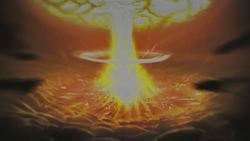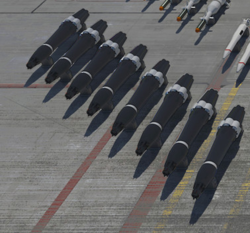Nuclear weapon
From Halopedia, the Halo wiki
| There is more information available on this subject at Nuclear weapon on the English Wikipedia. |
A nuclear weapon is a type of ordnance using nuclear fission and/or fusion as a source of energy. The yield of a nuclear weapon is measured in the amount of tons of "TNT" needed to generate an explosion of similar proportions.
Overview[edit]
Nuclear weapons are commonplace in the United Nations Space Command's arsenal and in select civilian uses. The UNSC uses nuclear weapons to great effect in space warfare, increasing their effectiveness with special payloads enhanced for vacuum use.[1] Throughout the Insurrection and early on in the Human-Covenant War, space-borne UNSC nuclear weapons used proximity-fused warheads that relied on the detonation's direct radiation and thermal shock, which quickly proved ineffective against Covenant warships' energy shielding. As a result, the UNSC developed new types of warheads sporting nuclear-pumped X-ray lasers[2] and Casaba Howitzer-type shaped-charge warheads known as "Spears", which focus the nuclear blast into a directed, relativistic plasma jet.[3] Conventional nuclear weapons are still used in planetary warfare as tools of last resort.[2] Some planetary nuclear weapons also have shaped-charge properties, such as the Mark 2550 Havok MFDD, a bunker buster warhead designed to direct its blast against underground targets.[4]
Commonly, the casings of UNSC nuclear weapons such as the FENRIS nuclear warheads are heavily reinforced, both to contain radiation and to boost the thermonuclear yield for containing the detonation for a split second longer.[5] The hardened cases also protect the nukes inside and prevent them from going off accidentally - it was noted that detonating a bomb next to a FENRIS warhead would barely scratch the casing.[6] There are various grades for the types of nuclear weapons. An example is the excavation-grade HAVOK tactical nuclear weapon. While presumably not as powerful as a military-grade weapon, a single warhead is described as being powerful enough to turn Ivanoff Station "into piñata" and was powerful enough to destroy Mantle's Approach and the Composer when detonated on the inside of the ship.
Nuclear weapons are also sold commercially, and are commonly used in asteroid mining. In 2511, an Insurrectionist suicide bomber used one such commercial explosive in a terrorist attack on the Haven arcology on Mamore, killing two million and injuring over eight million more.[7]
An operational idiosyncrasy of nuclear weapons is the result of containing fissile material. Fissile materials, such as plutonium, emit a readily detectable Čerenkov radiation signature upon exiting slipspace that negates stealth measures. As a result, if complete stealth is required, prowlers are forced to jettison any on-board nuclear weapons before transitioning back to normal space to avoid detection.[8] In addition, nukes launched from slipspace can easily be detected by enemy sensors, despite the use of stealth coatings or lead linings.[9]
The energy shielding used in Covenant warships has been noted to dampen the electromagnetic pulse generated by the detonation of a nuke inside the ship. The SPARTAN-IIs used this to their advantage when they destroyed a Covenant cruiser during the Fall of Reach, without risking damaging the nearby orbital defense generators.[10]
If nuclear arsenals are not available, especially during a situation where NOBLE Team needed one to destroy a Sh'wada-pattern supercarrier, one alternative is to use a Slipspace Drive in lieu of nuclear weaponry.
History[edit]
The first space-borne nuclear weapons were used during the Interplanetary War in the 22nd century.[11] However, they were not considered a viable weapon of space warfare for the next several hundred years; at the time of the start of the Insurrection in 2494 it was widely believed that fissile detonations in space were practically useless, as the vacuum of space severely reduces the explosive yield and the resulting electromagnetic pulse. As such, it came as a surprise to the UNSC when the Insurrectionists used a nuclear device in a space battle following the Callisto Incident, having hidden it in an asteroid in advance. When detonated, the nuke shattered the asteroid to molten pieces, which in turn destroyed one UNSC ship and severely damaged two more.[12] The Jiralhanae used nuclear weapons during their global civil war to such a degree that it set their species back hundreds of years.[13]
Engagements against the Covenant during the Human-Covenant War quickly proved conventional nuclear weapons' ineffectiveness against Covenant warships' shields, forcing the UNSC to develop more effective payloads.[2] The frequent deployment of nuclear weapons in space engagements constantly kept the UNSC's nuclear stockpiles near depletion. This occasionally forced them to resort to using obsolete nukes or unorthodox solutions.[14][15][16]
The Covenant did not generally use nuclear weapons, regarding them as "heretic" weapons. An exception to this were the Jiralhanae, who had no qualms about using captured UNSC nukes or any other UNSC matériel.[17][18] However, following the end of the war, remnant groups of the Covenant have adopted more liberal policies in regards to human weaponry for practical reasons. Human-made nuclear weapons have subsequently fallen into the hands of Covenant terrorists and cultists.[19]
UNSC nuclear ordnance[edit]
The UNSC employs a range of nuclear ordnance.
FENRIS nuclear warhead[edit]
- Main article: FENRIS nuclear warhead
The FENRIS is a type of low-yield thermonuclear device. They were slated for decommissioning but munition expenditures during the Human-Covenant War saw the survivors return to service.[14][15][20]
Fury tactical nuclear weapon[edit]
- Main article: Fury tactical nuclear weapon
The Fury, formally designated as the Medium Fusion Destructive Device,[21] is a rugby ball-sized device with a yield slightly less than a megaton. It is the "closest thing the UNSC has to a nuclear grenade".[22]
HAVOK tactical nuclear weapon[edit]
- Main article: HAVOK tactical nuclear weapon
HAVOK is a series of 30 megaton thermonuclear devices, which come in various configurations. Some were delivered by ground forces during the Human-Covenant War.[23][24][25] One was used to destroy the Composer and the Mantle's Approach, stopping the Didact's assault on Earth. Due to its many variants, it appears to be one of the most commonly used nuclear weapons.
HORNET mine[edit]
- Main article: HORNET mine
The HORNET is a 30 megaton space mine. The devices are designed to be more stealthy than an ordinary nuke and are carried aboard UNSC prowlers. Although like all nuclear weapons, they can be easily detected when exiting slipspace,[8] they can be rendered practically undetectable by cooling them to near-absolute zero temperatures, same as that of interstellar space, in their launch chambers.[26]
NOVA bomb[edit]
- Main article: NOVA bomb
The NOVA is a strategic device, and undoubtedly humanity's most powerful weapon. It consists of 9 nuclear warheads encased in a lithium triteride shell, which is compressed during detonation, boosting the yield "a hundred-fold".[27] A single NOVA has enough power to cause complete devastation on a planetary scale, and can destroy orbiting moons and naval fleets.[28]
Shiva-class nuclear missile[edit]
- Main article: Shiva-class nuclear missile
The Shiva is a type of starship ordnance.[29][30] They may also be carried by GA-TL1 Longswords.[31]
Rudra-class nuclear missile[edit]
- Main article: Rudra-class nuclear missile
The Rudra is another type of starship ordnance. The UNSC Port Stanley carried multiple enhanced yield Rudra nukes.[32]
Hyperion-class nuclear missile[edit]
- Main article: M4093 Hyperion nuclear delivery system
The Hyperion is a class of nuclear weapons shown to be carried by the UNSC Forward Unto Dawn that is capable of destroying a Zanar-pattern light cruiser in one hit if its shields are down.
Gallery[edit]
An unidentified nuke used by Samuel-034 to destroy the Unrelenting in Halo: Fall of Reach.
List of appearances[edit]
|
|
Sources[edit]
- ^ Halo: Ghosts of Onyx, "Chapter 35" page 326
- ^ Jump up to: a b c d Halo: Warfleet, p. 16
- ^ Halo: Warfleet, p. 92
- ^ Halo: Last Light, page 364 (Google Play edition)
- ^ Halo: Ghosts of Onyx, "Chapter 1", page 39
- ^ Halo: Ghosts of Onyx, "Chapter 23", page 209
- ^ Intersystem News: HAVEN TERROR BOMBING KILLS TWO MILLION
- ^ Jump up to: a b Halo: Ghosts of Onyx, "Chapter 22", page 187
- ^ Halo: Ghosts of Onyx, "Prologue", page 15
- ^ Halo: First Strike, "Chapter 3", page 25
- ^ Halo 4: The Essential Visual Guide, page 74
- ^ Halo: Evolutions - Essential Tales of the Halo Universe, "The Impossible Life and the Possible Death of Preston J. Cole", page 445
- ^ Halo: Envoy, page 42
- ^ Jump up to: a b Halo: Ghosts of Onyx, "Chapter 1", page 34
- ^ Jump up to: a b Halo: Ghosts of Onyx, "Chapter 23", page 205
- ^ Halo: Reach, campaign level Long Night of Solace
- ^ Halo: Ghosts of Onyx, "Chapter 23", page 207
- ^ Halo 2, campaign level Uprising
- ^ Spartan Ops, Departure
- ^ Halo: Ghosts of Onyx, "Chapter 24", page 215
- ^ Halo: Reach: Deliver Hope
- ^ Halo: First Strike, "Chapter 1", page 20
- ^ Halo: The Fall of Reach, page 200
- ^ Halo: The Fall of Reach, page 212
- ^ Halo Wars: Genesis, page 17
- ^ Halo: Ghosts of Onyx, page 325
- ^ Halo: First Strike, page 180
- ^ Halo: Ghosts of Onyx, page 244
- ^ Halo: The Fall of Reach, pages 147, 322-324
- ^ Halo: The Cole Protocol, page 82
- ^ Halo Encyclopedia: The Definitive Guide to the Halo Universe (2011), page 320
- ^ Halo: The Thursday War, page 320




